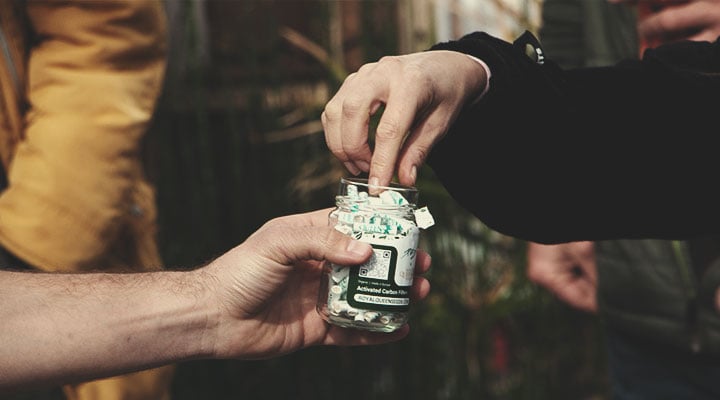.

Activated Carbon Smoking Filters — Should You Use Them?
Activated carbon filters do a great job at capturing carcinogens. This substance features many small pores and an adsorbent ability that makes it ideal for filtering nasty substances. We explore exactly what active carbon smoking filters can and cannot do, and if they are worth your time.
Contents:
We’re all aware of the dangers of smoking. Applying a flame to a bong bowl or the tip of a joint combusts the plant material, creating many of the same carcinogens found in tobacco smoke. Smoking cannabis, especially for long periods, increases the risk of respiratory conditions. But is there a less risky way to blaze? Cigarette filters help to block the largest tar particles from entering the lungs, and activated charcoal filters may take things one step further.
What Are Activated Carbon Filters?
Activated carbon filters aren’t exclusive to the world of weed. You can find them everywhere, from air purifiers, modern vacuum cleaners, and water filters. But why does charcoal have a place in all of these devices? Because they possess a whole lot of carbon. Charcoal developed lots of tiny internal spaces or pores following exposure to heat (more on that in a second). This gives activated carbon a vast surface area and plenty of spaces to trap molecules that pass through it in a liquid or gas form. In the context of smoke, activated charcoal manages to trap increased amounts of carcinogens and toxins that would otherwise enter the lungs.
-
How do they work?
Activated carbon filters work through the principle of adsorption. As opposed to absorption, which involves molecules soaking up into a substrate (like water into a sponge), adsorption refers to individual molecules sticking to the surface of an object. A common example of adsorption includes those small silica gel packets you find in new shoes and handbags that help to prevent dryness by tying up water molecules. Activated carbon filters work in much the same way. As molecules present in smoke pass through them, they become trapped in the many tiny pores and cling to the surface of the carbon.
-
How are activated carbon filters produced?
The production of activated carbon filters requires primarily two things: A suitable carbon source and lots of heat. Typically, several types of coal, coconut shells, and wood are used as carbon-rich materials in this process. But how does the carbon in these sources become “activated”? Well, manufacturers place them in tanks devoid of oxygen and heat them to sweltering temperatures of 600–900°C. After the first round of heating, they apply additional elements (mostly nitrogen) and then reheat the material once again to an even hotter temperature of up to 1200°C. This process changes the structure of the carbon by creating a plentiful amount of pores, creating a much larger surface area.
-
Do activated carbon filters absorb THC?
Here’s the trade-off: Activated carbon filters are highly effective at filtering out organic non-polar molecules (in this context, the word “organic” simply refers to a molecule that contains carbon). Some carcinogens present in smoke, such as polycyclic aromatic hydrocarbons (PAHs) are non-polar. However, as terpeno-phenolic compounds, so are cannabinoids. Molecules such as THC also have a large molecular weight, which means they’re likely to get caught up in the gauntlet of pores in activated carbon filters. Plus, small molecular weight and polar carcinogens such as hydrogen cyanide and carbon monoxide can make it through.
The bottom line: You’ll still get high from toking on a joint with an activated carbon filter. Sure, you’ll lose some THC, and some small polar carcinogens will still make it through. However, they decrease the amount of non-polar carcinogens that make it into your lungs, reducing the overall burden associated with joints and blunts smoked without these filters.
Are Activated Carbon Filters Healthier Than Alternatives?
So, are activated carbon filters worth an additional purchase? Is there any evidence that places them above using standard cigarette filters or simple cardboard roaches? Researchers have put quite a lot of effort into finding out how effective they really are. A 2018 study[1] published in the journal Chemical Research in Toxicology assessed the effects of charcoal filters on the free radical contents of cigarette smoke. Researchers found that they let 40% fewer of these unstable molecules through compared to non-charcoal cigarette filters. Another study[2], this one published in the Journal of Biosciences, also landed on similar findings. The research team behind this project found activated charcoal filters reduce p-benzosemiquinone (an irritate found in cigarette smoke) exposure associated with emphysema.


Activated Carbon Filters vs Cardboard Filters
Activated carbon filters are a superior choice to cardboard filters, also commonly referred to as roaches. In fact, cardboard tips don’t act as filters. Instead, they merely serve as a “handle” to a joint or blunt. They allow large quantities of carcinogens, tar, and toxins to pass through unabated. However, this open access situation means that cannabinoids and terpenes also pass through without any struggle.
Activated Carbon Filters vs Tobacco Filters
Activated carbon filters are better at capturing carcinogenic compounds than standard cigarette filters. Their many pores, large surface area, and ability to adsorb non-polar compounds makes them much more effective. As the first study mentioned above brought to light, standard cellulose acetate cigarette filters let through much higher levels of unstable free radicals that contribute to carcinogenesis.
How to Use Activated Carbon Filters
You can use carbon filters in the exact same way as a standard filter or roach. Simply insert them on either end of a rolling paper, pack it with bud, and roll away.
Are Activated Carbon Filters Eco-Friendly?
After finishing a smoking session, you need to place your carbon filters in the general waste bin once the remains of your joint have fully cooled down; they’re now loaded with tar, after all. However, some products are more environmentally-friendly than others based on their packaging and what they are made from.
RQS Activated Carbon Filters
RQS Activated Carbon Filters are an exciting collaboration between us and our friends over at Purize. This premium product contains 100 XTRA Slim Size filters in an upcycled glass jar (that you can either recycle or keep to store your bud). Our tips use activated carbon derived from organic coconut shells, and they’re made here in Europe. Not only do they do a great job at removing nasty substances, but each tip features two ceramic caps that contribute to a cool and aromatic smoking experience. We advise using each filter only once, but some of our customers report using them twice with no issues. As long as they remain sealed in their jars, you can keep these filters stored away for several years (they have no expiry date).
- Effect of Charcoal in Cigarette Filters on Free Radicals in Mainstream Smoke https://www.ncbi.nlm.nih.gov
- Activated charcoal filter effectively reduces p-benzosemiquinone from the mainstream cigarette smoke and prevents emphysema https://pubmed.ncbi.nlm.nih.gov







































